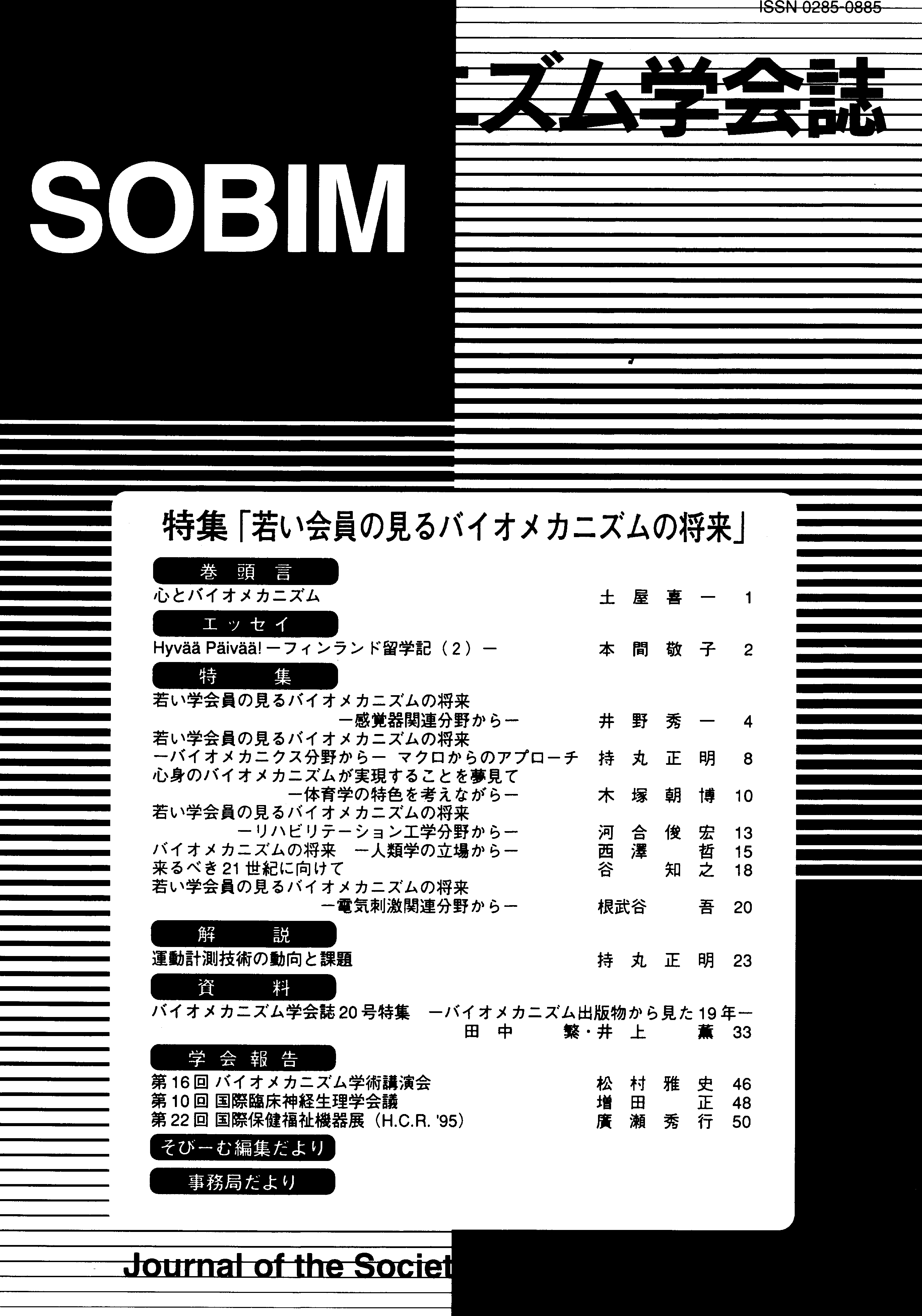巻号一覧

20 巻 (1996)
- 4 号 p. 156-
- 3 号 p. 108-
- 2 号 p. 56-
- 1 号 p. 1-
20 巻, 2 号
選択された号の論文の7件中1~7を表示しています
- |<
- <
- 1
- >
- >|
エッセイ
-
本間 敬子原稿種別: 本文
1996 年 20 巻 2 号 p. 56-
発行日: 1996/05/01
公開日: 2016/10/31
ジャーナル フリーPDF形式でダウンロード (191K)
解説
-
阿江 通良原稿種別: 本文
1996 年 20 巻 2 号 p. 57-62
発行日: 1996/05/01
公開日: 2016/10/31
ジャーナル フリーPDF形式でダウンロード (619K) -
湯 海鵬原稿種別: 本文
1996 年 20 巻 2 号 p. 63-69
発行日: 1996/05/01
公開日: 2016/10/31
ジャーナル フリーPDF形式でダウンロード (873K) -
渡部 和彦原稿種別: 本文
1996 年 20 巻 2 号 p. 70-73
発行日: 1996/05/01
公開日: 2016/10/31
ジャーナル フリーPDF形式でダウンロード (546K) -
山海 嘉之原稿種別: 本文
1996 年 20 巻 2 号 p. 74-81
発行日: 1996/05/01
公開日: 2016/10/31
ジャーナル フリーPDF形式でダウンロード (1075K) -
藤澤 弥生原稿種別: 本文
1996 年 20 巻 2 号 p. 82-85
発行日: 1996/05/01
公開日: 2016/10/31
ジャーナル フリーPDF形式でダウンロード (504K)
研究
-
Hirohumi HIRAYAMA, T. NISHIMURA, Y. FUKUYAMA原稿種別: Article
1996 年 20 巻 2 号 p. 86-96
発行日: 1996/05/01
公開日: 2016/10/31
ジャーナル フリーPulse wave velocities and wall displacements in arterial system have been known to be complicated functions of visco-elastic modulus, frequency, radius and tethering effects while we scarcely find a study for the isolated effects of arterial properties on arterial wall displacement and the pulse wave velocity because of the difficulty to alter the arterial properties independently. To make clear the isolated effects of wall properties, we applied thin walled linear cylindrical shell model subjected to longitudinal tethering effects with measurable initial stresses. Analysis was focused on the properties of thoracic artery. Because its wall thickness to radius ratio is below 0.1 and is suitable to apply thin wall theory. The linearized Navier-Stokes equations and wall motion equations involving tethering and initial wall stresses were solved analytically by setting linear harmonic solutions. The reported system parameters were adopted from the data which were measured in animal and human subjects. Increase in circumferential visco-elastic modulus of arterial wall accelerated the first type of pulse wave velocity C1. Increase in axial visco-elastic modulus did not influence on C1 but elevated the second type pulse wave velocity C2 more than by those in circumferential directions. The radial and the axial displacements due to the first type pulse wave velocity decreased hyperbolically with Eφ. They were elevated by the increase in the visco-elastic modulus in circumferential direction, while they were depressed by those in axial direction. The displacements due to C2 were smaller than those due to C1. The mechanism in the changes of wall displacements to the anisotropic nature were discussed in terms of incompressible nature of the wall and interaction with longitudinal tethering effect in cylindrical tube. Present investigation affords insight to evaluate the changes in mechanical properties of arterial wall by measuring the wall displecements and pulse wave velocities.抄録全体を表示PDF形式でダウンロード (828K)
- |<
- <
- 1
- >
- >|